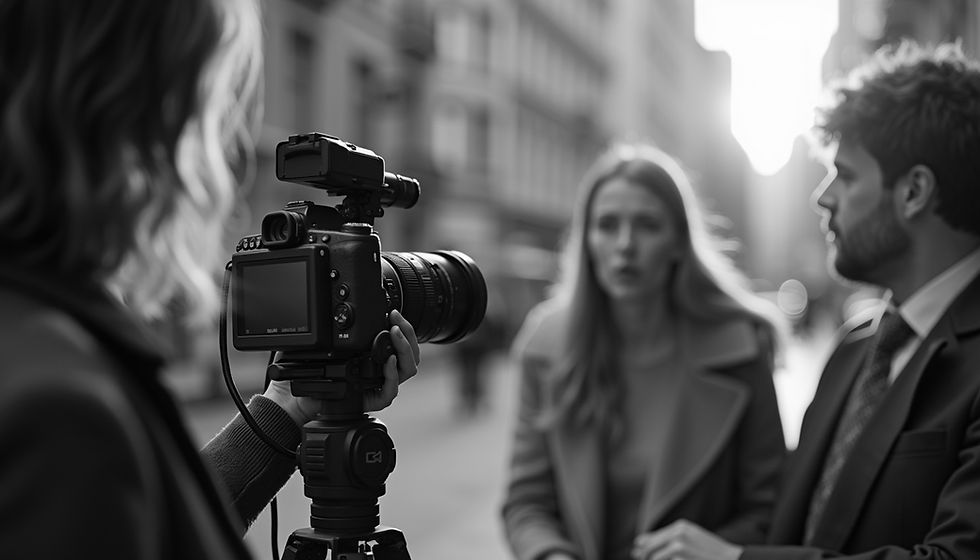Mastering the Art of Documentary Filmmaking
- Marlon Torres

- Oct 7
- 4 min read
When I first dipped my toes into the world of documentary video techniques, I had no idea how deep the rabbit hole would go. It’s not just about pointing a camera and hitting record. It’s about capturing truth, emotion, and stories that resonate. If you’re like me, eager to create something meaningful and visually compelling, you’re in the right place. Let’s walk through what it really takes to master this craft.
Understanding the Core of Documentary Video Techniques
Documentary video techniques are the backbone of any successful project. They shape how your story unfolds and how your audience connects with it. From framing your shots to choosing the right lighting, every decision matters.
One technique I swear by is the use of natural light. It adds authenticity and warmth that artificial lighting often struggles to replicate. For example, shooting during the golden hour can transform a simple interview into a cinematic moment.
Another key technique is the art of the interview. It’s not just about asking questions but creating a space where your subject feels comfortable enough to open up. I always prepare open-ended questions and listen more than I speak. This approach often leads to unexpected, powerful answers.
And then there’s B-roll footage. This is the visual glue that holds your story together. I like to capture plenty of B-roll — scenes that add context and emotion without words. Think of a close-up of hands working, or a wide shot of a bustling street. These shots enrich the narrative and keep viewers engaged.

Essential Documentary Video Techniques for Impactful Storytelling
Let’s get practical. What are some documentary video techniques that can elevate your project from good to unforgettable?
Storyboarding and Planning
Before you even pick up a camera, sketch out your story. What’s the arc? Who are your characters? What emotions do you want to evoke? Storyboarding helps you visualize scenes and plan your shots efficiently.
Camera Movement
Static shots can be powerful, but subtle camera movements like pans or dollies add dynamism. I often use a slow push-in during emotional moments to draw viewers closer to the subject.
Sound Design
Don’t underestimate sound. Ambient noise, music, and clear dialogue are crucial. I always carry a good external microphone and record room tone to smooth out edits.
Editing Rhythm
The pace of your edit controls the viewer’s emotional journey. Quick cuts can build tension, while longer takes allow reflection. I recommend experimenting with different rhythms to find what fits your story best.
Color Grading
Color sets the mood. Warm tones can feel inviting, while cooler hues might evoke distance or melancholy. I use color grading to subtly guide the audience’s feelings without distracting from the story.

How much does a 30 minute documentary cost?
Budgeting is often the elephant in the room. How much should you expect to spend on a 30-minute documentary? The answer varies widely depending on your goals, equipment, and team.
Here’s a rough breakdown based on my experience:
Pre-production (research, scripting, planning): $2,000 - $5,000
Production (filming, crew, equipment rental): $10,000 - $25,000
Post-production (editing, sound design, color grading): $5,000 - $15,000
Miscellaneous (travel, permits, licensing): $1,000 - $3,000
So, a 30-minute documentary can range from $18,000 to $48,000 or more. It’s a significant investment, but one that pays off when your story is told with clarity and impact.
If you’re working with a tight budget, focus on strong storytelling and efficient shooting. Sometimes, less is more. I’ve seen incredible documentaries made with minimal gear but maximum heart.

Why documentary filmmaking is a powerful tool for your message
I can’t stress enough how transformative documentary filmmaking is for businesses and organizations. It’s not just about telling a story; it’s about creating an emotional connection that drives action.
When I collaborate with clients, I focus on uncovering the why behind their message. What makes their story unique? How can we visually and emotionally engage their audience? This approach turns a simple video into a powerful narrative that resonates.
For example, a nonprofit I worked with wanted to highlight the impact of their work. Instead of just showing statistics, we filmed personal stories of those helped by the organization. The result? A video that moved donors to give and volunteers to join.
If you want your message to stand out, consider investing in professional documentary video techniques. It’s an investment in authenticity and trust.
Tips for Staying Ahead with Cutting-Edge Technology
Technology in video production evolves fast. Staying current can feel overwhelming, but it’s worth it. Here are some tips I’ve picked up along the way:
Use drones for aerial shots. They add a cinematic scale and perspective that’s hard to achieve otherwise.
Experiment with 4K and HDR. Higher resolution and dynamic range give you more flexibility in post-production.
Leverage mobile editing apps for quick turnarounds when you’re on the go.
Explore virtual reality (VR) and 360-degree video if your story benefits from immersive experiences.
Remember, technology is a tool, not a crutch. The story always comes first.
Mastering documentary video techniques is a journey. It requires patience, practice, and a willingness to learn from every shoot. But when you get it right, the results are nothing short of magical. Your stories will not only be seen but felt.
If you’re ready to take your video projects to the next level, consider partnering with experts who live and breathe this craft. After all, your story deserves to be told with passion and precision.




Comments